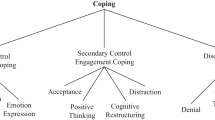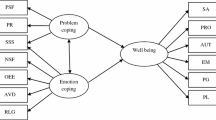Abstract
Various factors have an influence on which coping strategies are mobilized under specific circumstances, among others, age and gender. The present paper focuses on the interrelationships between the ways of coping and some health-related variables in adolescence. Data were collected among secondary school students (n = 1039) in Szeged, Hungary. Factor analysis of the shortened and adapted version of the Ways of Coping Questionnaire gave a four-factor solution: passive coping, problem-analyzing coping, risky coping, and support-seeking coping. Passive and support-seeking ways of coping were more common among girls, however, this latter way of coping proved to be a more significant correlate of psychosocial health among boys. Both among boys and girls, passive and risky coping factors played a negative role, and problem-analyzing and support-seeking coping factors played a positive role in psychosocial health. Findings suggest that maladaptive coping and psychosocial health problems might form a vicious circle in which risk-taking as a way of coping might play a central role in adolescence. When adolescents dispair of their problems, they often use drugs, smoke, or drink alcohol. They perceive it, however, rather as a form of risk-taking or sensation-seeking than a way of coping. That is why they do not reckon with its harmfulness and future consequences.
Similar content being viewed by others
References
AMIRKHAN, J. H. (1990). A factor analytically derived measure of coping: The coping strategy indicator. Journal of Personality and Social Psychology, 59, 1066–1074.
BEM, S. (1974). The measurement of psychological androgyny. Journal of Consulting and Clinical Psychology, 42, 155–162.
BUNNEL, D., COOPER, P., HERTZ, S., & SHENKER, I. (1992). Body shape concerns among adolescents. International Journal of Eating Disorders, 11, 79–83.
COMPAS, B. E., OROSAN, P. G., & GRANT, K. E. (1993). Adolescent stress and coping: implications for psychopathology during adolescence. Journal of Adolescence, 16, 331–349.
EHRENBERG, M. F., COX, D. N., & KOOPMAN, R. F. (1990). The Millon Adolescent Personality Inventory profiles of depressed adolescents. Adolescence, 25, 415–425.
ELKIND, D. (1984). All grown up and no place to go: Teenagers in crisis? Reading: Addison-Wesley.
ENDLER, N. S., & PARKER, J. D. A. (1990). Multidimensional assessment of coping: A critical evaluation. Journal of Personality and Social Psychology, 58, 844–854.
ERIKSON, E. H. (1968). Identity, youth, and crisis. New York: Norton Press.
FARRELL, C. M. (1993). Australian adolescent coping styles: A comparison of year 7 and year 11 male and female high school students. Master of Education thesis. University of Western Sydney.
FELDMAN, S. S., FISHER, L., RANSOM, D. C., & DIMICELI, S. (1995). Is ‘What is good for the goose good for the gander?’ Sex differences in the relationships between adolescent and adult adaptation. Journal of Research on Adolescence, 5, 333–336.
FOLKMAN, S., & LAZARUS, R. S. (1980). An analysis of coping in a middle-aged community sample. Journal of Health and Social Behaviour, 21, 219–239.
FOLKMAN, S., LAZARUS, R. S., DUNKEL-SCHETTER, C., DELONGIS, A., & GRUEN, R. (1986a). The dynamics of a stressful encounter. Journal of Personality and Social Psychology, 50, 992–1003.
FOLKMAN, S., LAZARUS, R. S., GRUEN, R. J., & DELONGIS, A. (1986b). Appraisal, coping, health status and psychological symptoms. Journal of Personality and Social Psychology, 50, 571–579.
FRYDENBERG, E. (1997). Adolescent coping. London and New York: Routledge.
FRYDENBERG, E., & LEWIS, R. (1991). Adolescent coping: The different ways in which boys and girls cope. Journal of Adolescence, 14, 119–133.
FRYDENBERG, E., & LEWIS, R. (1993). Boys play sport and girls turn to others: Age, gender and ethnicity as determinants of coping. Journal of Adolescence, 16, 252–266.
GILLIGAN, C. (1982). In a different voice. Cambridge Ma: Harvard University Press.
GJERDE R. F., & BLOCK, J. (1991). Preadolescent antecedents of depressive symptomatology at age 18: a prospective study. Journal of Youth and Adolescence, 20, 217–232.
HUMPHREY, L. L. (1989). Observed family interaction among subtypes of eating disorders using structural analysis of social behavior. Journal of Consulting and Clinical Psychology, 57, 206–214.
INGLEDEW, D. K., HARDY, L., COOPER, C. L., & JEMAL, H. (1996). Health behaviours reported as coping strategies: A factor analytical study. British Journal of Health Psychology, 1, 263–281.
KOPP, M., & SKRABSKI, A. (1996). Behavioural sciences applied to a changing society. Budapest, Hungary: Bibliotheca Septem Artium Liberalium.
NOLEN-HOEKSEMA, S. (1991). Responses to depression and their effects on the duration of depressive episodes. Journal of Abnormal Psychology, 100, 569–582.
PARSONS, A., FRYDENBERG, E., & POOLE, C. (1996). Coping strategies of adolescent males. British Journal of Educational Psychology, 66, 109–114.
PETERSEN, A. C., SARIGIANI, P. A., & KENNEDY R. E. (1991). Adolescent depression: Why more girls? Journal of Youth and Adolescence, 20, 247–271.
PIKO, B. (1996). Social support and health risk behaviour–are they interacting? Paper presented at the 10th Conference of the European Health Psychology Society, Dublin, Ireland.
PIKO, B. (1998). Social support and health in adolescence: A factor analytical study. British Journal of Health Psychology, 3, 333–344.
PIKO, B., BARABAS, K., & BODA, K. (1997). Frequency of common psychosomatic symptoms and its influence on self-perceived health in a Hungarian student population. European Journal of Public Health, 7, 243–253.
PIKO, B., BARABAS, K., & MARKOS, J. (1996). Health risk behaviour of a medical student population. Report on a pilot study. Journal of the Royal Society of Health, 116, 97–100.
RAUSTE-VON WRIGHT, M. (1987). On the life process among Finnish students: Summary report of a longitudinal study. Helsinki: Societas Scientiorium Fennica.
ROSS, C. E., & HAYES, D. (1988). Exercise and psychological well-being in the community. American Journal of Epidemiology, 127, 762–771.
STONE, A. A., & NEALE, J. M. (1984). New measure of daily coping: development and preliminary results. Journal of Personality and Social Psychology, 46, 892–906.
STROEBE, W., & STROEBE, M. S. (1995). Social psychology and health (pp. 201–228). Buckingham: Open University Press.
VAUX, A. (1985). Variations in social support associated with gender, ethnicity and age. Journal of Social Issues, 41, 89–110.
WHEATON, B. (1985). Models for the stress-buffering functions of coping resources. Journal of Health and Social Behavior, 26, 352–364.
Author information
Authors and Affiliations
Corresponding author
Additional information
This study was supported by the OTKA F 017968 research grant of the National Research Fund (Hungary).
Rights and permissions
About this article
Cite this article
Piko, B. Gender Differences and Similarities in Adolescents’ Ways of Coping. Psychol Rec 51, 223–235 (2001). https://doi.org/10.1007/BF03395396
Published:
Issue Date:
DOI: https://doi.org/10.1007/BF03395396




